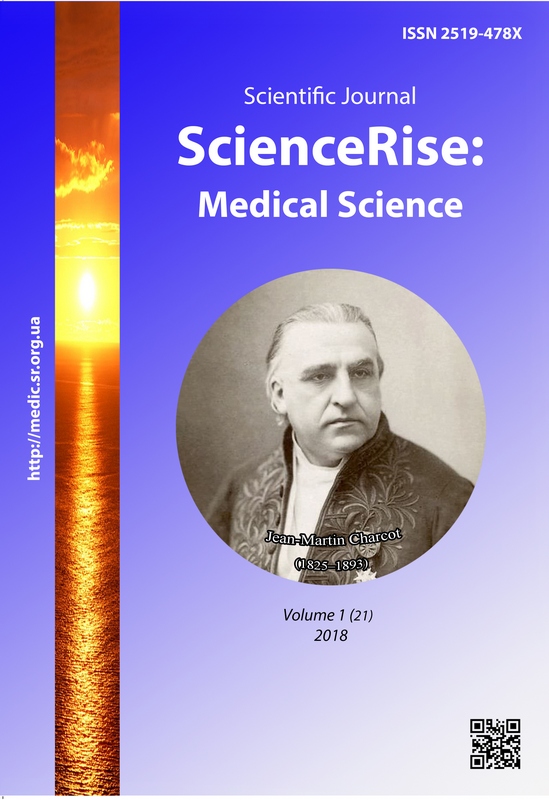Peculiarities of protein metabolism in pregnancy complicated by intrauterine infection
DOI:
https://doi.org/10.15587/2519-4798.2018.121784Keywords:
intrauterine infections, protein metabolism, implementation of intrauterine infectionAbstract
Purpose of the study. To determine the features of protein metabolism by changes in proteinograms in pregnant women with intrauterine infection.
Materials and methods. The examined 180 pregnant women were divided into 3 groups depending on the presence and nature of the infection: viral (CMV, herpes simplex virus types 1, 2, 6), bacterial (chlamydia, ureaplasma, mycoplasma) and mixed (viral-bacterial) infection. Each of these groups was divided into 2 subgroups: with subsequent implementation of infection in newborns (1) and without it (0). This group in the study was the main one. Control group included 50 patients with physiological pregnancy.
Serum of pregnant women was assessed for the content of total protein and protein fractions: albumin, total globulin fraction, alpha-1, alpha-2, beta and gamma globulin fractions.
Results. The study showed that protein composition of blood is most affected by viral infections. An increase in the level of gamma globulins is the most noticeable change in this case. However, patients with implementation of viral infection barely had a tendency to an increase in this fraction, while in the subgroup without implementation of this infection this increase was significant and quite expressed (by 30 %, p<00.05).
This increase in immunoglobulins, along with other conditions, will likely prevent further implementation of viral infection in newborns.
The presence of bacterial infection in the examined pregnant was also shown to have a weaker impact on protein metabolism. As a feature, we can note only slight hyperproteinemia (not more than 10 % higher than in control) in patients with implementation of bacterial infection, which was not observed in any of the other groups. This increase in the level of total protein could have developed due to the impact of infection on the genitourinary system and a disruption of excretion of nitrogenous compounds.
Combined viral and bacterial infections resulted in a more pronounced effect of the viral infection, although this group was found to have certain features in the form of moderate dysproteinemia with a decrease in albumin level and an increase in alpha and beta globulin fractions.
Conclusions. This study showed that intrauterine infection in pregnant women can affect protein composition of blood serum. The peculiarities of the impact of different types of infectious agents are variously reflected in their action on various aspects of protein metabolism in pregnant womenReferences
- Soma-Pillay, P., Nelson-Piercy, C., Tolppanen, H., Mebazaa, A. (2016). Physiological changes in pregnancy. Cardiovascular Journal of Africa, 27 (2), 89–94. doi: 10.5830/cvja-2016-021
- Soma-Pillay, P., Nelson-Piercy, C., Tolppanen, H., Mebazaa, A. (2016). Physiological changes in pregnancy. Cardiovascular Journal of Africa, 27(2), 89–94. doi: 10.5830/cvja-2016-021
- Zhang, Z., Adelman, A., Rai, D., Boettcher, J., Lonnerdal, B. (2013). Amino Acid Profiles in Term and Preterm Human Milk through Lactation: A Systematic Review. Nutrients, 5 (12), 4800–4821. doi: 10.3390/nu5124800
- Zubovskaya, E. T., Vilchuk, K. U., Kurlovich, I. V., Mitroshenko, I. V., Barsukov, A. N., Nagibovich, S. Y. (2013). Features of laboratory parameters in pregnant women. Laboratory Diagnostics, 4, 43–55.
- Avagliano, L., Garo, C., Marconi, A. M. (2012). Placental Amino Acids Transport in Intrauterine Growth Restriction. Journal of Pregnancy, 2012, 1–6. doi: 10.1155/2012/972562
- Elango, R., Ball, R. O. (2016). Protein and Amino Acid Requirements during Pregnancy. Advances in Nutrition: An International Review Journal, 7 (4), 839S–844S. doi: 10.3945/an.115.011817
- Kazakova, V. V., Demidenko, L. A., Sataieva, T. P. (2016). Eatures of free amino acid content in biological fluids of pregnant women. Modern scientific researches and innovations, 2. Available at: http://web.snauka.ru/issues/2016/02/62247
- Gutikova, L. V. (2012). Plasma amino acid levels in women with gestosis before and after delivery. Rossiyskiy vestnik akushera-ginekologa, 12 (6), 10–13.
- Khlybova, S. V., Tsirkin, V. I. (2008). The content of free amino acids in the physiological course of the gestational process and a number of obstetric complications. Medical Almanac, 5, 68–71.
- Zhubyrke, S., Garaeva, S., Leorda, A., Furdui, V., Postolati, G., Redkozubova, G., Covarscaia, N. (2017). Free amino acids plasma spectrum of the pregnant minors in the third trimester. Studia Universitatis Moldaviae, 1 (101), 29–36.
Downloads
Published
How to Cite
Issue
Section
License
Copyright (c) 2018 Mikola Shcherbina, Liudmyla Vygivska

This work is licensed under a Creative Commons Attribution 4.0 International License.
Our journal abides by the Creative Commons CC BY copyright rights and permissions for open access journals.
Authors, who are published in this journal, agree to the following conditions:
1. The authors reserve the right to authorship of the work and pass the first publication right of this work to the journal under the terms of a Creative Commons CC BY, which allows others to freely distribute the published research with the obligatory reference to the authors of the original work and the first publication of the work in this journal.
2. The authors have the right to conclude separate supplement agreements that relate to non-exclusive work distribution in the form in which it has been published by the journal (for example, to upload the work to the online storage of the journal or publish it as part of a monograph), provided that the reference to the first publication of the work in this journal is included.









